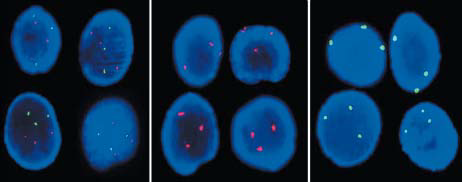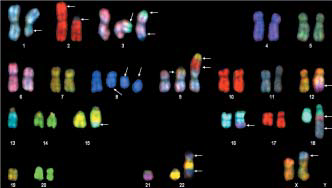
Centre for Human Genetics
Bangalore.

Bangalore.

Dr. Jayarama S. Kadandale. PhD, Mysore University. Post-Doctoral Fellowship, University Tennessee Health Science Centre, USA
My lab performs conventional and molecular cytogenetic analysis for diagnosis of genetic disorders prenatally, postnatally and in cancer. Overthe past 14 years we have analysed around 28,000 samples (peripheral blood, skin, amniotic fluid,chorionic villi, cord blood, bone marrow, fine needle aspirate and tissue biopsy). We employ state of-the-art technologies, including molecular hybridization (FISH), primed in situ labelling(PRINS), spectral karyotyping (SKY), mFISH and mBANDing, to confirm or rule out particular chromosomal abnormalities.We also aid other institutions in diagnosing such disorders by providing second opinions on difficult cases.We regularly conduct training courses and workshops in conventional cytogenetics, FISH, and in immortalization of cells using the Epstein-Barrvirus. We have provided training and other forms of support to doctors and lab scientists from about14 hospitals and medical colleges in Karnataka and one in Chhattisgarh to enable them to set up basic chromosome labs in their institutions.
 13/21 18 X/Y
Prenatal diagnosis of a triploid foetus employing DNA probes for 13, 18, 21, X and Y chromosomes
We have conducted, on average, two hands-on workshops a year on diagnostic cytogenetics, human cell culture, transformation and cell banking. The participants have included clinicians, postgraduate students and lab personnel from biotech industry and hospitals. Several specialized workshops have been held on prenatal FISH,chromosome breakage syndromes and on methods in the diagnosis of leukemias.The main focus of research in my lab is breakpoint mapping of apparently balanced chromosome translocations in families with abnormal phenotypes. Mapping breakpoints in disease associated,apparently balanced chromosome rearrangements has been instrumental inidentification of many disease genes and is used as a shortcut method for detection of the genes involved. In most cases, the phenotype is causedby disruption or deletion of a gene or genes in the breakpoint region(s). Relatively few cases exhibiting position effects have been described.Molecular characterization of chromosomal breakpoint in disease-associated balanced translocations has led to elucidation of many hereditary diseases, thus defining candidate breakpoints for nail-patella, Prader-Willi and Schmidt syndromes, ataxia, and ulna aplasia. Anotable example is the characterization of the fusion protein BCR-ABL in the (9;22)translocation in chronic myeloid leukaemia.
13/21 18 X/Y
Prenatal diagnosis of a triploid foetus employing DNA probes for 13, 18, 21, X and Y chromosomes
We have conducted, on average, two hands-on workshops a year on diagnostic cytogenetics, human cell culture, transformation and cell banking. The participants have included clinicians, postgraduate students and lab personnel from biotech industry and hospitals. Several specialized workshops have been held on prenatal FISH,chromosome breakage syndromes and on methods in the diagnosis of leukemias.The main focus of research in my lab is breakpoint mapping of apparently balanced chromosome translocations in families with abnormal phenotypes. Mapping breakpoints in disease associated,apparently balanced chromosome rearrangements has been instrumental inidentification of many disease genes and is used as a shortcut method for detection of the genes involved. In most cases, the phenotype is causedby disruption or deletion of a gene or genes in the breakpoint region(s). Relatively few cases exhibiting position effects have been described.Molecular characterization of chromosomal breakpoint in disease-associated balanced translocations has led to elucidation of many hereditary diseases, thus defining candidate breakpoints for nail-patella, Prader-Willi and Schmidt syndromes, ataxia, and ulna aplasia. Anotable example is the characterization of the fusion protein BCR-ABL in the (9;22)translocation in chronic myeloid leukaemia.

Spectral karyotype showing multiple translocations in a Myeloma patient
Selected publications:
1.Pre- and postnatal diagnosis of 5q35.1 and 8p23.1 deletion in congenital heart disease.Indian Journal of Pediatrics, 83: 1484-1485 (2016). Shetty M, SrikanthA, Kulshreshtha P, Kadandale J, Hegde S
2.Goldenhar syndrome. International Journal of Anatomy and Research, 4: 2076-2079 (2016). RLakshmi PS, Anupama D, Bhat M, Kadandale J,Harshal KL
3.Next-generation sequencing reveals novelmutations in X-linked intellectual disability.OMICS, 21: 295-303 (2017). Muthusamy B, SelvanLDN, Nguyen TT, Manoj J, Stawiski EW, Jaiswal BS,Wang W, Raja R, Ramprasad VL, Gupta R, MuruganS, Kadandale JS, Prasad TSK, Reddy K, Peterson A,Pandey A, Seshagiri S, Girimaji SC, Gowda H
4.Clinical and molecular characterization of Prader-Willi syndrome.Indian Journal of Pediatrics,84: 815-821(2017). Sanjeeva GN,Maganthi M, Kodishala H, Marol RKR, KulshreshthaPS, Lorenzetto E, Kadandale JS, Hladnik U,Raghupathy, Bhat M
5.Analysis of complex chromosomal abnormalities in a case of multiple myeloma using spectral karyotyping. Asian Journal of Pharmaceutical and Clinical Research 11: 9-11 (2018). Govindasamy P,Kulshrestha PS, Pandurangan P, Tarigopula A,Kadandale J, Samuel CR
Copyright © 2011 - All Rights Reserved - Taurus Hard Soft Solutions Pvt. Ltd
Stay Up to Date With Whats Happening